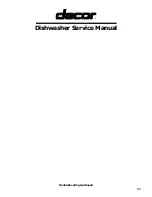
-
It is important to try and run the dishwasher when it is fully
loaded to save on energy. In order to prevent odors from form-
ing and food from caking onto the dishes, you can run the hold
cycle.
- Choose the right wash cycle: the choice of cycle depends on
the type of dishware, cookware and utensils being washed and
how dirty they are.
Energy Saving Tips
- Use the right amount of detergent: if you use too much detergent,
the result will not be cleaner dishes, but, rather, a greater nega-
tive impact on the environment.
- There is no utility in rinsing dishes, cookware and untensils
before placing them in the dishwasher.
How to Keep Your Dishwasher in Shape
After Every Wash
After every wash, turn off the water supply to the appliance and
leave the door slightly ajar so that moisture and odors are not
trapped inside.
Remove the Plug
Before cleaning or performing maintenance, always remove the
plug from the socket. Do not run risks.
No Solvents or Abrasive Cleaning Products
To clean the exterior and rubber parts of the dishwasher, do not
use solvents or abrasive cleaning products. Rather, use only a
cloth and warm soap water.
To remove spots or stains from the surface of the interior, use a
cloth dampened with water and a little white vinegar, or a clean-
ing products made specifically for dishwasher.
When You Go on Holiday
When you go on holiday, it is recommended that you run a wash
cycle with the dishwasher empty and then remove the plug from
the socket, turn off the water supply and leave the door of the
appliance slightly ajar. This will help the seals last longer and pre-
vent odors from forming within the appliance.
Moving the Appliance
If the appliance must be moved, try to keep it in the vertical position.
If absolutely necessary, it can be positioned on its back.
Seals
One of the factors that cause odors to form in the dishwasher is
food that remains trapped in the seals. Periodic cleaning with a
sponge will prevent this from occurring.
Wash Cycle Table
.8.
.7.
GB
GB
Cycle
Eco
Button
Cycle Selection
Information
Description of
Cycle
Deter-
gent
Rinse
Aid
Intensive
Wash
I n t e n s i v e
Wash
Normal Wash
Rinse
Glassware
Soak
Very dirty dishes, pots and
pans (not to be used with
delicate items).
Very dirty dishes, pots and
pans. (not to be used with
delicate items)
Normally dirty dishes, pots
and pans. Standard daily
cycle.
For dishes that need to be
rinsed and dried only.
Economic, fast cycle to be
used for items which are sen-
sitive to higher. Run immedi-
ately after dishes are used.
Pre-wash of dishes, pots and
pans while waiting for the
load to be completed after
the subsequent meal.
Pre-wash with cold water.
Rinse with cold water.
Extended wash at 60
Rinse with hot water at 68
Drying.
Pre-wash with hot water.
Rinse with cold water.
Extended wash at 50
Rinse with hot water at 60
Drying.
Rinse with cold water.
Extended wash at 60
Rinse with hot water at 68
Drying.
Extended wash at 60
Rinse with hot water at 68
Drying.
Wash at 50
.
Hot Rinse at 55
Drying.
Short cold wash to prevent
food residue from drying on
the dishes
30g
30g
25g
15g
N o r m a l W a s h
(IEC-EN50242)
25g
Normally dirty dishes, pots
and pans. Standard daily
cycle.
Rinse with cold water.
Extended wash at 50
Rinse with hot water at 60
Drying.
Rinse
For dishes that need to be
rinsed and dried only.
Extended wash at 50
Rinse with hot water at 60
Drying.
























